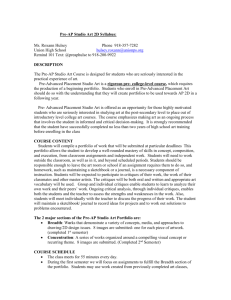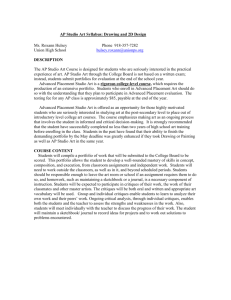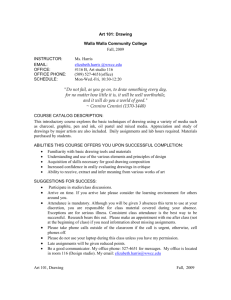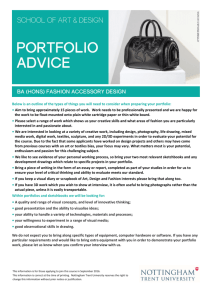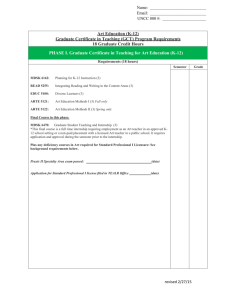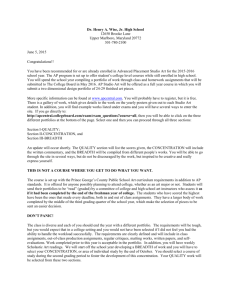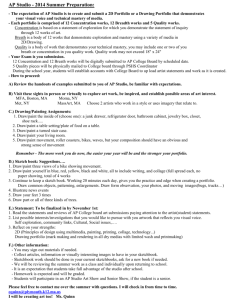AP® Studio Art: Drawing, 2-D, and 3-D Syllabus - Ms. Kay
advertisement
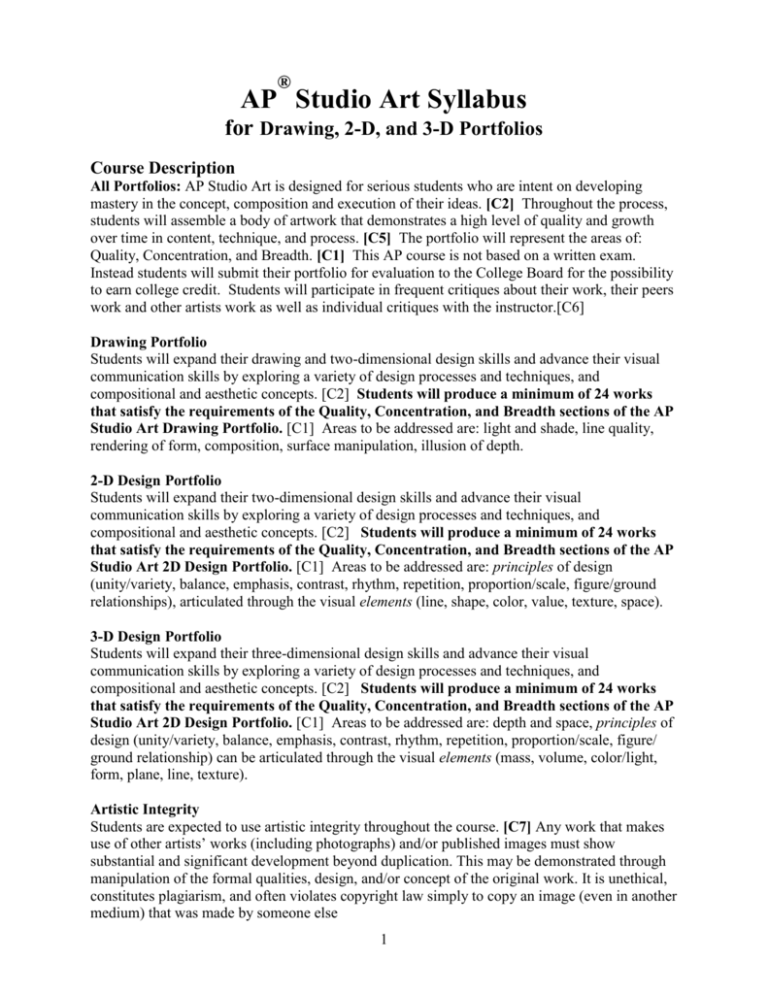
® AP Studio Art Syllabus for Drawing, 2-D, and 3-D Portfolios Course Description All Portfolios: AP Studio Art is designed for serious students who are intent on developing mastery in the concept, composition and execution of their ideas. [C2] Throughout the process, students will assemble a body of artwork that demonstrates a high level of quality and growth over time in content, technique, and process. [C5] The portfolio will represent the areas of: Quality, Concentration, and Breadth. [C1] This AP course is not based on a written exam. Instead students will submit their portfolio for evaluation to the College Board for the possibility to earn college credit. Students will participate in frequent critiques about their work, their peers work and other artists work as well as individual critiques with the instructor.[C6] Drawing Portfolio Students will expand their drawing and two-dimensional design skills and advance their visual communication skills by exploring a variety of design processes and techniques, and compositional and aesthetic concepts. [C2] Students will produce a minimum of 24 works that satisfy the requirements of the Quality, Concentration, and Breadth sections of the AP Studio Art Drawing Portfolio. [C1] Areas to be addressed are: light and shade, line quality, rendering of form, composition, surface manipulation, illusion of depth. 2-D Design Portfolio Students will expand their two-dimensional design skills and advance their visual communication skills by exploring a variety of design processes and techniques, and compositional and aesthetic concepts. [C2] Students will produce a minimum of 24 works that satisfy the requirements of the Quality, Concentration, and Breadth sections of the AP Studio Art 2D Design Portfolio. [C1] Areas to be addressed are: principles of design (unity/variety, balance, emphasis, contrast, rhythm, repetition, proportion/scale, figure/ground relationships), articulated through the visual elements (line, shape, color, value, texture, space). 3-D Design Portfolio Students will expand their three-dimensional design skills and advance their visual communication skills by exploring a variety of design processes and techniques, and compositional and aesthetic concepts. [C2] Students will produce a minimum of 24 works that satisfy the requirements of the Quality, Concentration, and Breadth sections of the AP Studio Art 2D Design Portfolio. [C1] Areas to be addressed are: depth and space, principles of design (unity/variety, balance, emphasis, contrast, rhythm, repetition, proportion/scale, figure/ ground relationship) can be articulated through the visual elements (mass, volume, color/light, form, plane, line, texture). Artistic Integrity Students are expected to use artistic integrity throughout the course. [C7] Any work that makes use of other artists’ works (including photographs) and/or published images must show substantial and significant development beyond duplication. This may be demonstrated through manipulation of the formal qualities, design, and/or concept of the original work. It is unethical, constitutes plagiarism, and often violates copyright law simply to copy an image (even in another medium) that was made by someone else 1 Course Goals The instructional goals of the AP Studio Art program can be described as follows: • to encourage creative and systematic investigation of formal and conceptual issues.[C4], [C5] • to emphasize making art as an ongoing process that involves the student in informed and critical decision making to develop ideation. [C1] • to help students develop technical skills and familiarize them with the functions of the visual elements. [C4] • to encourage students to become independent thinkers who will contribute inventively and critically to their culture through the making of art. [C7] (From the AP Studio Art Course Description) Expectations & Requirements AP Studio Art Students will: -participate in frequent class presentations, discussions and critiques about their work, their peers work and other artists work [C6] -attend class on a regular basis and work diligently towards quality completion of assignments [C2] -maintain a sketchbook of their ideas throughout the duration of the class -complete the required assignments per semester -expand knowledge and skill level in art concepts and techniques -work independently and take initiative in producing art -seek and give advice of peers and instructor in group settings and independently -maintain a safe and clean work area in the classroom -work on their art for a minimum of an hour daily at home Homework This course is structured after a college art course, where one hour of class equals two hours of independent study. Students should dedicate a minimum of one hour daily for at home art making. Supplies The Art Department will make every attempt to provide the necessary materials for student work. The instructor will explore inexpensive options for supplies with the students. If the student is determined to create art with an expensive medium it will be at their expense. Students will have a $20 art fee to cover a sketchbook and a set of supplies to use throughout the school year, these will become property of the student and do not need to be returned. Cost Although there is no written AP exam for this course, there is a exam fee for registration, processing and “reading” or evaluating the portfolio. After submitting a portfolio for the exam, a score is determined, which will merit college credit based on the colleges’ AP policy. The fee of $91.00 (rate for 14-15) is required and will be paid before May. The College Board provides a fee reduction for qualified students with acute financial need. 2 Art Exhibitions There are several art shows during the year. Students should plan to enter the portfolio category of the Scholastic Art Show in January. Other shows like the District Art Show and local art shows occur in April and May. In addition to entering work in shows, as a class we will take art related field trips to galleries, museums and/or exhibitions when the opportunity allows. Grading Work will be evaluated using the AP Studio Art rubric or a simplified version. In an effort to ensure that students will be prepared for the portfolio submission, all projects must be completed by the deadline. Report Card grades will reflect completion of a minimum of 6 high-quality pieces per quarter. These pieces must be complete in concept, composition and execution as well as technical skill. [C2] Students must complete 12-14 pieces of work by the end of the 1st semester to pass the Mid-term Exam. Portfolio assignments are worth 70% and additional assignments, such as: sketchbooks, research on an artist or era, critiques and museum visits, are worth 30% of the student’s grade. Students will have advanced notice of these due dates. 3 Grading Rubric Score Work at this level: -Is consistently of high quality -shows obvious evidence of thinking 6 Excellent -demonstrates verve(image choice) -addresses fairly complex visual and/or conceptual ideas -uses materials well, technique is excellent -shows evidence of experimentation and/or risk taking -shows strong evidence of informed decision making -is generally strong, although there may be some inconsistencies -shows evidence of thinking in that it is about something 5 -is fairly confident Strong -has a grasp of the elements & principles of design -shows a strong sense of the student’s individual transformation -has some sense of direction but may not be fully resolved -exhibits some degree of success 4 -shows that some manipulation of ideas is evident Good -demonstrates that some technical aspects are handled well but sometimes do not match the idea -indicates that, if other source materials are used, the student’s voice can still be discerned -may show a sense of real effort but problems are not successfully resolved -may be more accomplished technically than it is conceptually 3 Moderate -demonstrates that an awareness of the elements & principles of design is emerging -is erratic in technique, with little or no sense of challenge -shows some ambition while achieving only moderate success -indicates that, if other source materials are used, the student’s voice is minimal -is technically weak or awkward -is simplistic in addressing solutions to problems 2 -shows no clear intent Weak -Is limited in artistic decision making -indicates that, if other source materials are used, the student’s voice is not discernable 1 Poor -shows little, if any, evidence of thinking/artistic decision making -is poor in technique -is trite in addressing solutions to problems -has poor composition -work is obviously copied from photographic sources or from the work of others 4 Course Overview Assignments will be divided up by the two semesters or four quarters that comprise the school year. The school schedule is composed of five 55 minute class periods. Each semester students will have 12-14 pieces towards their portfolio due. Assignments will be tailored to fit the needs of the students’ interests, media and portfolio. A new assignment will be due/given every 2-3 weeks and will address a variety of design issues in the respective course. Deadlines will be staggered to allow students to work on assignments simultaneously. In-progress critiques and final project critiques will be scheduled regularly to correspond with each project. [C6] Students will complete an “Assignment Progress Sheet” for each assignment to record the creative process and to manage their time. 1st Semester First semester (September – mid-January) will be spent working on teacher driven assignments that are suitable for the Breadth section of their particular portfolio. [C4] During the completion of the Breadth pieces, it is anticipated that students will discover their strengths, favored imagery, media and personal direction for their Concentration section. [C3] In October and November students will discuss and narrow down their ideas for the concentration section and begin working on their first pieces. Students will draft an artist statement informing the viewer about their work using descriptive diction and art terminology. [C6] Students will learn/accomplish the following in their respective course: -introduction to a variety of materials and techniques through demonstrations & application -introduction to a range of conceptual issues with historical, contemporary and contextual references [C4] -understand artistic integrity as applied to their work [C7] -confidence and application of design by use of elements and principles of design in work -achieve quality in the completion of a variety of assignments [C2] -investigate bodies of work to plan and develop an acceptable Concentration [C3] -receive guidance in planning works and media for specific pieces [C1] -discover and determine areas of great strength & interest and create a project proposal for the Concentration section [C5, C6] 2nd Semester Second semester (mid-January – May) will be spent working on student driven assignments towards completion of the Concentration section of the portfolio. The concentration section should demonstrate a visual cohesion throughout the work. At this time students will revisit their artist’s statement and create a finalized version. Students will learn/accomplish the following in their respective course: -complete pieces that demonstrate breadth, concentration and quality in an evolving process [C2, C4, C5] -visual problem solving in regard to design issues and theme [C3] -selecting materials and techniques to suit theme and ideation [C4] -determine a sequence to demonstrate the developing body of work in technique and quality [C2] -complete sequencing, slide labeling, written statement, registration based on explicit directions -receive guidance in planning works and media for specific pieces [C1] 5 In April, students will focus on selecting works for the Quality section, completing unfinished works organizing slides and assembling their portfolio for the Exam. In May after the portfolios are mailed, students will create a digital portfolio of their AP Studio work, artist statement, written reflections, critiques and research. The remainder of the class will be devoted to experimental projects that were not able to be covered during the course and studio maintenance and clean-up. Suggestions for Breadth and Concentration Assignments, a non-exhaustive list Drawing Areas of Breadth -a series of expressive landscapes based upon personal experience of a particular place -a personal or family history communicated through the content and style of still-life images -abstractions from mechanical objects that explore mark-making -interpretive self-portraiture and figure studies that emphasize exaggeration and distortion -a project that explores interior or exterior architectural space, emphasizing principles of perspective, structure, ambiance created by light, etc. -an interpretive study of literary characters in which mixed media, color and form are explored -the use of multiple images to create works that reflect psychological or narrative events Drawing Areas of Concentration -the use of various spatial systems, such as linear perspective, the illusion of three-dimensional forms, aerial views and other ways of creating and organizing space -the use of various subjects, such as the human figure, landscape and still –life objects -the use of various kinds of content, such as that derived from observation, an expressionistic viewpoint, imaginary or psychological imagery, social commentary, political statements and other personal interests -arrangements of forms in a complex visual space -the use of different approaches to represent form and space, such as rendered, gestural, painterly, expressionist, stylized or abstract form 2-D Areas of Breadth -work that employs line, shape, color to create unity or variety in a composition -work that demonstrates symmetry/asymmetry, balance, anomaly -work that explores figure/ground relationships -development of a modular or repeat pattern to create rhythm -color organization using a color scheme or color relationship for emphasis or contrast in a composition -work that investigates or exaggerates proportion or scale 6 2-D Areas of Concentration -an exploration of patterns and designs found in nature or culture -a series of works that begins with representational interpretations and evolves into abstraction -a series of landscapes based upon personal experience of a particular place in which composition and light are used to intensify artistic expression -development of a series of identity products for imaginary businesses -a series of political cartoons using current events and images -abstractions developed from cell or other microscopic images -interpretive portrait or figure studies that emphasize dramatic composition or abstraction -a personal or family history communicated through symbols or imagery -a series of fabric or apparel designs or weavings used to express particular themes 3-D Areas of Breadth -work that embodies line, plane, mass, volume to activate form in space -work that suggests rhythm through structure -work that uses light or shadow to determine form, with particular attention to surface and interior space -work that demonstrates an understanding of symmetry/asymmetry, balance, anomaly, and implied motion -assemblage or construction work that transforms materials or object identity through the manipulation of proportion/scale -work in which the color and texture unify and balance the overall composition of the piece -work that explores the concept of emphasis/subordination through a transition from organic to mechanical form 3-D Areas of Concentration -a series of three-dimensional works that begins with representational interpretations and evolves into abstraction -a series of site-specific works that affect existing form or space -abstraction developed from natural or mechanical objects -figurative studies that emphasize expression and abstraction -wheel-thrown and hand-built clay objects that allude to human, animal or manufactured forms -theuse of multiples/modules to create and disrupt three-dimensional space -a series of sculptures that explodes the relationship between interior and exterior space 7 AP Studio Art Assignment Progress Sheet Name__________________________ Title/Subject/Medium________________________ Studio Course: Drawing 2-D 3-D Portfolio Section: I. Quality II. Concentration Monday Work accomplished: Problem/Solution: I need to: Tuesday Work accomplished: Problem/Solution: I need to: Wednesday Work accomplished: Problem/Solution: I need to: Thursday Work accomplished: Problem/Solution: I need to: Friday Work accomplished: Problem/Solution: I need to: 8 Week of: ______________________ III. Breadth References General Texts AP Studio Art Poster. New York: The College Board, 2006. AP Studio Art Course Description. The College Board, 2006. Davis, Maggie. (2003). AP Studio Art Teacher’s Guide. The College Board. Douglas-Cooper, Helen. (Ed.). (2004). The Artist’s Bible. Quatro Publishing. Getlein, Mark. (2004). Gilbert’s Living with Art, (7th ed.). Boston: McGraw-Hill Higher Education. Gregory, Danny. (2006). The Creative License. Hyperion. Howlett, Margaret. (Ed.). Scholastic Art Magazine. Scholastic Inc. ISSN 1060832X Hudson, Suzanne., Noonan-Morrissey, Nancy. (2002). The Art of Writing about Art. Wadsworth Group. Hannah, Gail Greet, Kostellow, Rowena Reed. (2002). Elements of Design. Princeton: Architectural Press Roukes, Nicholaus. (1998) Art Synectics: Stimulating Creativity in Design. Worchester, MA: Davis Publications Inc. Salome, Richard., Hobbs, Jack. (2005). The Visual Experience. (3rd ed.). Worchester, MA: Davis Publications Inc. Stewart, Mary. (2006). Launching the Imagination. McGraw-Hill Higher Education Wong, Wucious. (1993). Principles of Form and Design. Wiley Press 3D Texts Luecking, Stephen. (2002). Principles of Three-Dimensional Design. Prentice Hall. McCreight, Tim. (2004). The Complete Metalsmith, Student Edition. Brynmorgen Press. Revere, Alan. (2001). The Art of Jewelry Making Classic & Original Designs. Sterling Publications. Rich, Jack C. (1973). The Materials and Methods of Sculpture. Dover Publications. Rourkes, Nicholas. (1993). Sculpture in Paper. Worchester, MA: Davis Publications Inc. Sprintzen, Alice. (2000). The Jeweler’s Art-A Multi-Media Approach. Worchester, MA: Davis Publications Inc. 9 Warshaw, Josie. (2006). The Practical Potter. Anness Publishing Ltd. Drawing Texts Curtis, Brian. (2002). Drawing from Observation. McGraw Hill Higher Education. Edwards, Betty. (1999). The New Drawing on the Right Side of the Brain. New York: Penguin Putnam Inc. Edwards, Betty. (2002). The New Drawing on the Right Side of the Brain Workbook. New York: Penguin Putnam Inc. Hogarth, Burne. (2002). Dynamic Light and Shade. Watson-Guptill Publishers. Nicolaides, Kimon. (1969). The Natural Way to Draw. Houghton Mifflin Co. Rose, Ted., Mahan-Cox, Sallye. (2007). Discovering Drawing. (2nd ed.). Worchester, MA: Davis Publications Inc. The Diagram Group (1999). Complete Drawing Course. Sterling Publishing Co., Inc. Painting Texts Edwards, Betty. (2004). Color, A Course in Mastering the Art of Mixing Colors. New York: Penguin Putnam Inc. Jelber, Wendy., Sidaway, Ian. (2005). Painting with Watercolors, Acrylics and Gouache. Anness Publishing Ltd. Perry, Vicky. (2005). Abstract Painting, Concepts and Techniques. New York: Watson-Guptil Publications. Other Texts London, Barbara., Stone, Jim. (2006). A Short Course in Photography. ( 6th ed.). Pearson Prentice-Hill. London, Barbara., Stone, Jim. (2005). Photograph. (8th ed.). Pearson Prentice-Hill. Martin, Judy. (1998). The Encyclopedia of Printmaking Techniques: The Step-By-Step Visual Directory of Printmaking Techniques, Plus Projects and an Inspirational Gallery of Finished Prints. Encyclopedia of Art Series. Philadelphia: Running Press. Perrella, Lynne. (2004). Artists’ Journals & Sketchbooks. Quarry Books. Taylor, Terry. (2004). Altered Art. New York: Lark Books. 10 Websites AP Central®. www.apcentral.collegeboard.com Artcyclopedia www.artcyclopedia.com Artlex: Dictionary www.artlex.com Art Studio Chalkboard www.2.evansville.edu/studiochalkboard/index.html The Figure Drawing Lab www.2.evansville.edu/drawinglab/ 11

